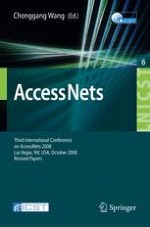The annual International Conference on Access Networks (AccessNets) aims to provide a forum that brings together researchers and scientists from academia as well as man- ers and engineers from industry to meet and exchange ideas and recent work on all aspects of access networks. AccessNets 2008 was the third edition of this event, which was successfully held in Las Vegas, Nevada, USA, during October 15–17, 2008. The conference consisted of two keynote addresses, five invited talks, seven technical sessions, and two panel sessions. Leonid Kazovsky from Stanford University and Kevin Schneider, Chief Technology Officer of ADTRAN, delivered their exciting keynote - dresses on “Future Evolution of Broadband Access,” and “Carrier Ethernet and the Evo- ing Access Networks,” respectively. Maurice Gagnaire, Martin Reisslein, Martin Maier, Paolo Giacomazzi, and John M. Cioffi gave interesting invited talks on different research topics on access networks. The technical papers presented original and fundamental - search advances in the area of access networks, while the panels focused on the interesting topics of “Fiber Assisted Wireless for Broadband Access Networks and Dynamic Spectrum Management (DSM) Successes. ” These conference proceedings include all the technical papers that were presented at AccessNets 2008. We hope that it will become a useful reference for researchers and practitioners working in the area of access networks.
